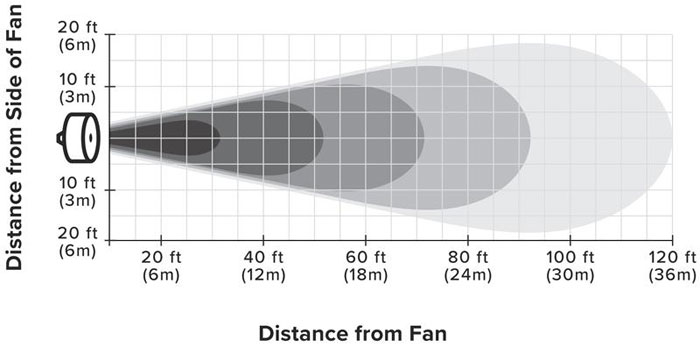How does an overhead Big Ass fan affect airflow?
The powerful bi-directional airflow and elevated air speed of an overhead fan by Big Ass Fans Australia provide the required comfort to users of the space. Airflow underneath the fan is pushed downward while outside the fan’s blades, the airflow transitions to horizontal air movement, providing comfortable airflow over a large area as per ASHRAE Standard 55’s thermal comfort calculations.

How does a directional Big Ass fan affect airflow?
Big Ass directional fans create a one-way airflow pattern that moves air to the area in front of the fan. Directional fans are most often used to keep workers cool in congested areas where overhead fans cannot be safely mounted. Additionally, most Big Ass directional fans feature variable speed control, allowing users to adjust airflow to provide the optimal desired cooling effect.
How can I use Big Ass fans to improve ventilation within my space?
Fresh air is generally not distributed uniformly throughout a space. One of the most common air distribution configurations for HVAC systems is an overhead supply with overhead return. In common heating applications, this ceiling configuration can cause significant stratification of heated supply air and room air layers, preventing fresh air from circulating to the occupant level.
To compensate, ASHRAE 62.1 requires ventilation rates to be increased by 20% to deliver the necessary amount of fresh air to the room’s occupants. In a room that has been de-stratified by a Big Ass overhead fan, however, the air layers are well mixed so that the supplied fresh air can reach occupant level.
Naturally ventilated spaces have fresh air passively distributed throughout the space, leading to stagnant pockets in localised areas that result in poor air quality and pollutant build-up. By dispersing these pockets, Big Ass fans increase the circulation of fresh air, evenly distributing it throughout the space and improving indoor air quality.
How much will increased air movement improve ventilation in my space?
This CFD analysis of the industrial space below shows the measurable benefits offered by a Big Ass overhead fan.

Warehouse is approximately 699ft x 378ft (213m x 115m) with a ceiling height of 40ft (12m)
In this example, a 24-foot Powerfoil X3.0 pushes airflow directly downward in an area of roughly 500 square feet. Horizontally, the fan is able to push airflow over a dramatically larger area (depending on mounting height, floor level obstructions, fan model, etc.). For a custom CFD simulation of improved airflow for your space, please consult a Big Ass Fans sales associate.
How should I operate my fans during public health situations such as flu season?
There are many variables at play within each unique facility and application. Without data and intensive study for each case, the health impact of elevated air speed in a facility will remain inconclusive. Big Ass Fans values customer safety and well-being above all else and encourages following best practices outlined by the CDC and WHO in addition to adhering to building design standards and practices set forth by ASHRAE.
Ventilation can reduce the concentration of airborne pathogens through dilution. Increased ventilation rates (outdoor air intake) can provide a higher dilution capability and potentially reduce the risk of infection.
Big Ass Fans recommends:
- All facilities should meet or exceed the latest practice standards, including but not limited to ASHRAE Standard 62.X for ventilation and ASHRAE Standard 55 for thermal
comfort conditions.
- In naturally ventilated spaces, maximise the intake of dilution ventilation (outdoor air) whenever possible and distribute to all building occupants.
- Practice good respiratory hygiene: Occupants should cough or sneeze into an elbow or tissue and wash their hands regularly.
- Clean and disinfect frequently touched objects and surfaces such as workstations, keyboards, telephones, handrails, and doorknobs.

